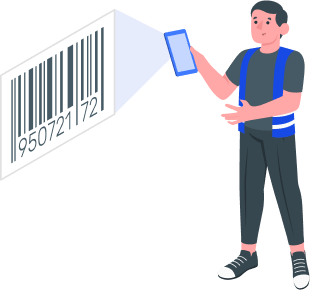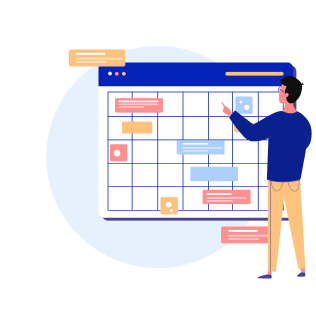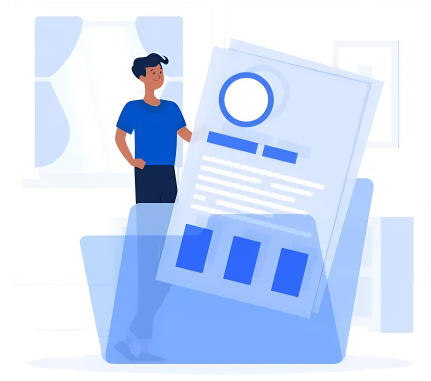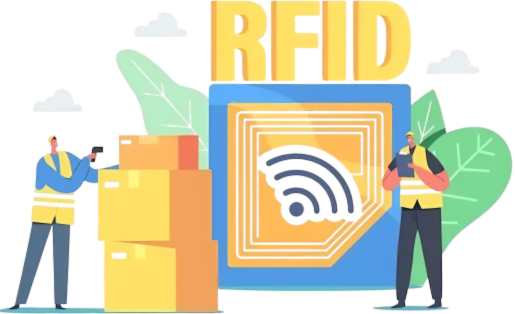Introduction
Ever had a laptop vanish or a surprise audit uncover missing equipment? Medium-to-large enterprises often face these problems across thousands of devices and tools. Without a tracking system, asset losses and audit surprises are common. Companies can lose millions annually to misplaced equipment and theft.
Asset tagging uses unique IDs like barcodes or RFID tags to track assets efficiently. By giving each asset a distinct “license plate,” it connects physical assets with digital records seamlessly. Teams can quickly locate items, plan maintenance, and simplify audits through fixed asset tagging. Overall, asset tagging empowers IT, Finance, and Audit teams to manage assets from tagging to disposal.
What is Asset Tagging? (Definition)
Asset tagging involves attaching a unique identifier to each physical asset for tracking. This ID may use barcodes, QR codes, RFID chips, or GPS trackers. The identifier connects directly to the asset’s record in a centralized database. Through physical asset tagging, organizations maintain visibility and control across every asset’s lifecycle.
In simple terms, asset tagging gives each piece of equipment an identity that can be scanned or read. When someone scans the asset tag, they can pull up key information about that item. For example, the system can show the asset’s owner, current location, purchase date, maintenance history, and other relevant data.
Asset tagging turns physical assets into trackable data, ensuring efficient management. It builds the base for automated counts and quick searches for missing items. Through fixed asset tagging, records stay accurate across the asset lifecycle. Simply put, asset tagging connects the physical and digital worlds, revealing what, where, and how assets are used.
Why Asset Tagging Matters (Benefits by Role)
Asset tagging isn’t just an IT concern – it delivers value across multiple departments. Different teams each gain specific benefits from a good asset tagging system:

-
Benefits for IT Departments
– Inventory control & visibility: Accurate hardware inventory prevents ghost assets and improves capacity planning.
– Efficient maintenance & support: Tags let IT retrieve device info (specs, history) instantly for faster troubleshooting and upgrades.
– Security & loss prevention: Tagged equipment is tracked to users, deterring theft and aiding recovery if a device is lost.
– Automation & ITSM integration: Tag data links with ITSM tools (like linking assets to help desk tickets) to streamline processes.
-
Benefits for Finance Teams
– Accurate asset valuation & depreciation: An up-to-date tag register ties each asset to its cost and depreciation schedule, keeping financial records accurate.
– Audit readiness & compliance: Scannable tags provide proof of existence and location, making audits faster and more accurate.
– Loss reduction & cost savings: Missing assets are flagged early – tagging reduces lost equipment and theft, saving replacement costs.
– Better procurement decisions: Tag utilization data prevents over-purchasing and guides smarter budgeting (e.g., redeploy under-used assets instead of buying new).
-
Benefits for Audit & Compliance Teams
– Streamlined asset audits: Scanning tags turns tedious inventory checks into quick, automated verifications, reducing audit time and errors.
– Regulatory compliance & record-keeping: Digital tag records (serial numbers, locations, maintenance logs) provide a clear audit trail to satisfy regulators.
– Improved traceability & control: Every tag logs the asset’s history (users, transfers, service), helping prevent unauthorized use or misplacement.
– Fraud and theft deterrence: With all assets tagged and logged, it’s much harder for anything to vanish without a digital trail – a strong deterrent against misuse.
How Asset Tagging Works (Technologies & Methods)
Asset tagging employs various technologies to meet diverse operational needs. Each method assigns a machine-readable code linked to a database for precise tracking. Moreover, the following tagging asset types illustrate how each technology functions.
⇒Barcodes and QR Codes
-
1D Barcodes:
A classic barcode uses lines and spaces to store numeric or alphanumeric IDs. When scanned with a reader or smartphone, it displays the asset’s ID and details. Barcodes are affordable and ideal for fixed asset tagging across IT and office equipment. However, they need line-of-sight scanning, hold limited data, and require one-by-one verification.
-
QR Codes:
QR codes are 2D matrix squares that store more data than standard barcodes. They can hold URLs or long IDs and are easily scanned with smartphones. In asset tagging, a QR code links directly to an asset’s database profile. While great for field teams and mobile access, they still need line-of-sight and one-by-one scanning.
-
Usage:
Barcodes and QR codes are ideal for offices, warehouses, and libraries prioritizing low cost and easy scanning. Moreover, they work best in controlled environments where users can quickly locate and scan each label.
⇒RFID Tags
-
Radio-Frequency Identification (RFID):
RFID asset tracking uses tags with small radio transmitters and memory chips. Unlike barcodes, RFID enables wireless scanning without line-of-sight from several feet away. Readers can capture hundreds of tags per second, speeding up inventory counts dramatically. RFID tags include passive types activated by readers and active ones that transmit continuously.
-
Data & range:
RFID tags store an asset ID and limited additional data for tracking. High-frequency RFID reads within a few meters, while UHF extends up to 10 meters. Moreover, warehouses and data centers use RFID for rapid, large-area asset tracking and improved efficiency.
-
Usage:
RFID works best for tracking large asset volumes or high-value equipment efficiently. For instance, hospitals can scan entire areas nightly to locate missing devices. Though RFID asset tagging costs more than barcodes and faces signal interference, specialized tags reduce issues. Many organizations adopt a hybrid model—using RFID for critical assets and barcodes for others.
Learn more about how to choose the right asset tracking tags>>
⇒NFC Tags
-
Near Field Communication (NFC):
NFC is a subset of RFID technology commonly found in smartphones (for contactless payments, etc.). NFC tags are tiny chips that store a small amount of data and communicate over very short ranges (a few centimeters) when tapped by an NFC-enabled device.
-
Use in asset tagging:
NFC tags embed directly into labels, enabling instant access with just a phone tap. Employees can view asset details or update records without extra scanners. Moreover, this makes physical asset tagging fast, convenient, and ideal for managing IT or office equipment.
-
Limitations:
NFC has a very short read range (by design) and typically works one tag at a time (no bulk reading). It’s great for controlled access or interactive scenarios (e.g., tapping an equipment tag to mark it “checked out” to a user). Essentially, NFC achieves what a barcode scan does, but with radio technology and added convenience in certain cases.
⇒GPS Trackers
-
GPS-based asset tags:
These active GPS devices include receivers and cellular or satellite transmitters for data reporting. They continuously determine and send their location to a central server. Moreover, GPS tags enable real-time tracking of mobile assets across wide areas.
-
Use cases:
Fleet vehicles, heavy equipment, and high-value mobile assets often use GPS tags for tracking. These trackers display real-time locations on a map, improving visibility and control. Moreover, they’re invaluable for monitoring assets in transit or spread across multiple sites.
-
Power and cost:
GPS trackers are larger devices needing a power source, such as batteries or wired connections. They cost more, so they’re used mainly for critical movable assets. For example, logistics teams tag trucks or trailers for real-time route monitoring. Facilities teams use tagging assets with GPS to locate essential equipment like generators during outages.
Explore how asset tagging helps prevent tool and equipment loss>>
⇒Bluetooth Low Energy (BLE) Beacons
-
BLE tags:
Integrate your asset tagging system with ERP or ITSM platforms for seamless efficiency. Linking with ERP automatically syncs updates to financial records, while CMDB integration shows configuration details instantly. Moreover, this connection streamlines fixed asset tagging, removes duplicate data, and keeps asset IDs consistent across systems.
-
Characteristics:
BLE tags are battery-powered but designed for long life (months or even years on a coin-cell battery) due to their low energy use. They have a shorter range than RFID or GPS – often effective within one room or up to ~30–50 meters (depending on walls and interference).
-
Use cases:
BLE enables indoor real-time location tracking through tagged assets and nearby receivers. Hospitals can monitor wheelchairs or IV pumps, while offices track valuable IT devices. It supports zone-based asset tagging, showing which room or area assets occupy. For example, a BLE tag on a projector helps IT confirm its correct placement instantly.
-
Infrastructure:
BLE tracking requires receivers to catch the beacon signals. These could be fixed Bluetooth gateway devices around the facility, or even employees’ smartphones acting as crowdsourced scanners. When a BLE tag comes into range, the system notes its ID and location automatically.
-
Advantages & challenges:
The key benefit is automation—no need to manually scan each asset. **BLE asset tagging** updates data continuously in the background, saving time and effort. However, it needs multiple receivers and offers less precise location accuracy than RFID. Still, it provides seamless, real-time monitoring of asset presence with minimal human involvement.

Summary:
Each asset tagging technology balances cost, range, and complexity differently. Most enterprises use barcodes or QR codes for affordability and RFID for faster audits. Moreover, GPS or BLE tags handle remote or movable assets effectively. Modern systems integrate multiple tagging assets, enabling unified, efficient management across one platform.
Explore how geo-tagging helps track assets in real time>>
Step-by-Step Asset Tagging Implementation Plan (How-To)
Implementing asset tagging in a medium or large enterprise involves planning, execution, and ongoing management. Follow these steps to roll out a successful asset tagging program:
-
Define Objectives and Scope:
Clearly outline why you are tagging assets and what success looks like. Identify the pain points to solve (e.g. reduce lost laptops, speed up yearly audits, improve maintenance tracking). Decide the scope: which locations, departments, and asset categories are included initially. A defined goal and scope will guide all other decisions.
-
Create an Asset Inventory:
Create a complete list of all assets you intend to tag before starting. Record essential details like name, category, location, owner, and value for each item. This inventory forms the base of your asset tagging database for accurate tracking. Using a structured template or spreadsheet ensures no physical asset tagging is missed and sets a reliable baseline.
-
Determine Which Assets to Tag:
Tagging every item isn’t always practical, so define clear selection criteria first. Focus asset tagging on assets that are high-value, critical, mobile, or compliance-related. For instance, skip low-value supplies but tag laptops, servers, and vehicles. Document your fixed asset tagging rules to ensure consistency and team-wide understanding.
-
Assign Unique Asset IDs:
Create a clear, consistent naming convention to make each asset ID unique and readable. Include department or asset type codes, such as IT-LAP-001 for laptops. Avoid relying solely on manufacturer serial numbers since they may repeat or confuse users. A custom, concise fixed asset tagging scheme ensures quick recognition and easy tag management across teams.
-
Choose Tag Technology & Materials:
Choose the asset tagging method that best fits your environment and operational needs. Use barcodes or QR codes for simplicity, or RFID for faster bulk scanning. For outdoor or rugged conditions, opt for durable metal or laminated tags. When tracking vehicles or field gear, GPS or BLE tags enable real-time visibility. Always test sample tags for compatibility, readability, and durability before full rollout.
-
Print or Acquire Tags:
After selecting the tag type, acquire or print your physical asset tags accordingly. You can create barcode or QR labels internally or order pre-serialized tags from vendors. Each tag should display your company name, unique asset ID, and scannable code. For RFID asset tagging, program each chip with its ID, then organize tags by category or location for efficient deployment.
-
Apply Tags to Assets:
Apply each asset tag securely in a consistent, easy-to-scan location. Clean and dry surfaces to ensure strong adhesion and durability. Moreover, use specialized tags for metal, cables, or high-temperature equipment. After physical asset tagging, scan samples to verify accuracy and proper data linkage.
-
Enter/Import Data into the System:
Enter all asset details and tag IDs into your tracking system for accuracy. Moreover, import data from spreadsheets to save time and maintain consistency. Include ID, description, location, and assigned user for each record. This links physical asset tagging to digital data, enabling instant retrieval with every scan.
-
Integrate with Other Systems:
Integrate your asset tagging system with ERP or ITSM platforms for seamless efficiency. Linking with ERP automatically syncs updates to financial records, while CMDB integration shows configuration details instantly. Moreover, this connection streamlines fixed asset tagging, removes duplicate data, and keeps asset IDs consistent across systems.
-
Train Your Team:
Integrate your asset tagging system with ERP or ITSM platforms for seamless efficiency. Linking with ERP automatically syncs updates to financial records, while CMDB integration shows configuration details instantly. Moreover, this connection streamlines fixed asset tagging, removes duplicate data, and keeps asset IDs consistent across systems.
-
Maintain and Audit Continuously:
Asset tagging needs ongoing maintenance to stay accurate and efficient. Schedule regular audits to match physical assets with records and resolve discrepancies. Moreover, replace damaged tags, update ownership details, and retire old IDs promptly. Continuously refine fixed asset tagging using feedback and emerging technologies like RFID for long-term reliability.
(Each of the above steps can be structured as a How-To schema, and the overall list serves as a guide for implementing an asset tagging program.)

Ready to Tag Smarter?
Schedule a Free Demo with AssetCues – barcode printing, digital tracking, and effortless audits.
Ready to Tag Smarter?
Schedule a Free Demo with AssetCues – barcode printing, digital tracking, and effortless audits.

Asset Tagging Systems and Tools
To make asset tagging work in practice, you’ll rely on a combination of hardware and software. This ecosystem of tools integrates to form a complete tagging solution:
⇒Hardware: Tags, Labels & Scanners
-
Asset tags & labels:
These physical labels or plates identify assets clearly and reliably. They range from printed barcodes to metal plates or embedded RFID/NFC chips. Moreover, choose materials suited to environmental conditions for lasting readability. In harsh or secure areas, use tamper-evident or heat-resistant asset tagging labels that remain scannable over time.
-
Label printing equipment:
If you print barcodes or QR codes internally, use a reliable thermal transfer printer for durability. In-house printing allows quick creation of new or replacement asset tags whenever needed. Many teams use label design software to add logos, custom layouts, or color codes. This approach ensures flexible, professional, and consistent physical asset tagging across all assets.
-
Scanning devices:
Depending on your tag technology, you’ll use different scanners:
- Handheld barcode scanners or mobile devices (smartphones/tablets with a scanning app, or Bluetooth barcode scanners) for barcodes and QR codes.
- RFID readers – handheld wands or fixed gateway antennas – for reading RFID tags in bulk.
- NFC-enabled smartphones for scanning NFC tags with a tap (most modern phones can serve as NFC readers).
- GPS trackers don’t require a handheld scanner; instead, you have a tracking interface that receives location updates from the tag.
- BLE receivers or gateways (dedicated devices or even phones/computers) to detect BLE beacon tags within range.
-
Network connectivity:
Plan how scanners and smart tags connect with your central system efficiently. Handheld devices sync via Wi-Fi or cellular networks, while RFID readers use local or IoT gateways. Moreover, in large asset tagging setups, middleware or edge devices streamline data collection and transmission.
⇒Software: Asset Tracking Platforms
At the core of asset tagging lies the software that manages all asset data and tag activity. This system could be an EAM, ITAM, CMMS, or an ERP module with asset management capabilities. It connects every tag scan to the correct asset record, ensuring real-time accuracy. When choosing software, prioritize features that streamline tracking, integration, and reporting.
-
Tag-based inventory lookup:
The ability to input or scan a tag ID and instantly pull up that asset’s record. For example, scanning a barcode or RFID tag retrieves that asset’s details (owner, location, status, etc.) immediately.
-
Support for multiple tag types:
If you use a mix of RFID and barcodes (or other types), the system should handle both seamlessly – associating each asset record with one or more tag identifiers.
-
Mobile app support:
A good platform offers a mobile app for scanning and updating assets on the go. This is crucial for field audits or maintenance rounds, where staff can scan asset tags and update records in real time.
-
Reporting and audit trails:
The system should log tag scans and changes – recording who did what, when – to provide accountability. It should also offer useful reports (e.g., assets not scanned in the last 90 days, upcoming maintenance due, depreciation reports).
-
Maintenance integration:
For operational assets, it’s helpful if the platform can log work orders or service history per asset. Scanning the tag should show if that asset is due for maintenance or has past repair records. This ties asset tracking to maintenance management.
-
Integration capabilities:
Your asset tagging platform should integrate seamlessly with other enterprise systems like ERP, ITSM, or procurement. Modern tools offer APIs, webhooks, or CSV import/export for smooth data exchange. ERP integration syncs financial details, while ITSM links tagged assets directly to support tickets. Such connectivity ensures unified, accurate asset data across all business systems.
-
User-friendly interface:
Since multiple teams depend on it, your asset tagging software should be intuitive and adaptable. Include bulk import/export, custom fields, and role-based access for secure collaboration. Moreover, user-friendly design boosts adoption and keeps fixed asset tagging efficient across departments.
Choose between cloud-based and on-premise systems based on operational needs. Cloud platforms offer easy remote access, while on-premise ensures stronger security and control. Moreover, whichever you select, ensure it scales with growth, supports backups, and protects your asset tagging data.
Common Asset Tagging Challenges (and Solutions)
Implementing asset tagging at scale can present some challenges. Here are three common issues enterprises face, and how to address them:
-
Challenge 1: Multi-Site Rollout Consistency
-
The issue:
Rolling out asset tagging across multiple offices, warehouses, or regions can lead to inconsistencies. Different sites might use different tag formats or processes, undermining a unified system. Without coordination, you risk duplicate asset IDs, incompatible data, or confusion when aggregating records.
-
Solution:
Set and enforce company-wide asset tagging standards right from the beginning. Create a global policy covering ID format, tag placement, and required asset data. Include location codes in IDs (e.g., NYC- or LON-) to keep them unique enterprise-wide. Roll out in phases, starting with a pilot site, refining, then expanding using proven practices. Assign a trained local asset champion at each site to maintain quality and compliance. Review site data regularly, conduct spot audits, and uphold a consistent fixed asset tagging system across all locations.
-
-
Challenge 2: Label Durability in Harsh Environments
-
The issue:
Tags can wear out or detach over time, especially in harsh environments. Outdoor, high-temperature, or chemical exposure can cause fading or peeling. A missing or damaged tag makes the asset untrackable until re-tagged. For instance, a paper barcode on outdoor equipment may fade or wash off, defeating the purpose of asset tagging.
-
Solution:
Use durable tag materials suited to environmental conditions for long-lasting performance. Choose anodized aluminum, stainless steel, or laminated polyester for industrial use. For high heat, apply ceramic or metal labels with protective laminates. Moreover, inspect tags regularly, replace worn ones, and keep ID logs. For critical assets, combine RFID chips with engraved numbers to ensure reliable asset tagging.
-
-
Challenge 3: Tracking Accuracy & Data Quality
-
The issue:
An asset tagging system is only as good as its data. Common problems include assets not being scanned regularly (so location info goes stale), users forgetting to update the system when moving assets, or data entry errors. Over time, the asset database can “drift” from reality, undermining trust. Additionally, RFID scans can sometimes pick up stray tags or miss some tags if not done carefully, affecting count accuracy.
-
Solution:
Establish clear processes to maintain accurate asset tagging data across teams. Assign ownership for updates after moves or disposals, ensuring accountability. Moreover, promote a “scan and update” habit using mobile apps for quick changes. Automate tracking with RFID or BLE systems, and schedule regular audits to prevent errors. Finally, set alerts for anomalies to keep data clean, reliable, and audit-ready.
-

Curious How Asset Tagging Works?
From tag placement to real-time scanning and reporting—see the full journey of smarter asset management in action.

Curious How Asset Tagging Works?
From tag placement to real-time scanning and reporting—see the full journey of smarter asset management in action.
Asset Tagging Use Cases & Examples
Asset tagging applies to virtually any physical asset. Here are a few common use cases and real-world examples illustrating its versatility:
-
IT Asset Management (Hardware & Devices)
A global tech company tags all laptops, desktops, and mobile devices with unique barcodes. Each tag links to an IT asset system tracking users, configurations, and warranties. Moreover, this asset tagging ensures visibility, accountability, and smooth lifecycle management.
-
-
Scenario:
When a new laptop is purchased, IT attaches an asset tag before issuing it. The employee scans the tag to link their user ID with the asset record. Throughout its lifecycle, each service, move, or reassignment triggers a quick scan and update. This keeps fixed asset tagging data accurate, reflecting real-time ownership and location changes.
-
Outcome:
This process greatly reduces equipment loss and improves accountability across departments. When employees leave, HR can instantly identify tagged assets that need returning. During audits, IT staff can scan devices to ensure all are accounted for, minimizing “ghost assets.” Many enterprises using asset tagging save costs by redistributing underused devices and verifying software compliance. If a tagged laptop is stolen, its record is flagged, allowing quick identification upon return or service.
-
Learn more about using IT asset tagging for better visibility and control>>
-
Facilities & Equipment Management
A manufacturing company tags all major equipment—from HVAC units to safety gear—with durable barcode or RFID labels. Moreover, this asset tagging ensures easy identification, reliable tracking, and improved efficiency in demanding industrial environments.
-
-
Scenario:
Each equipment tag links directly to its maintenance schedule in the company’s CMMS. During inspections, technicians scan the tag to view service history and record new work instantly. When a machine moves to another site, scanning updates its location automatically. This integration keeps asset tagging data accurate and ensures maintenance records stay current across locations.
-
Outcome:
Facility managers gain real-time visibility into equipment across all sites through asset tagging. They can instantly identify each item’s location and maintenance status, avoiding duplicate purchases. For example, finding an unused tagged motor at another site saved thousands of dollars. The system also ensures safety compliance by prompting timely inspections of critical assets. Additionally, scanning a QR tag enables quick access to repair guides or ticket submission with accurate asset details.
-
-
Tool Tracking in Field Operations
A construction company tags all tools, machinery, and high-value consumables using durable QR and RFID labels. Moreover, workers use a mobile app to scan tags, checking tools in and out seamlessly. This asset tagging approach improves visibility, accountability, and on-site efficiency.
-
-
Scenario:
Each morning, the foreman scans tool tags as workers receive assignments. At day’s end, tools are scanned again when workers return them. If unreturned, the system flags it and records the last handler. Over time, usage logs show frequency, users, and replacement timelines by wear.
-
Outcome:
Theft prevention is a major benefit here. Construction site theft is a serious problem – over $1 billion worth of equipment and tools is stolen from U.S. job sites every year. Active Tracking & daily tracking, missing tools or equipment are detected instantly, not weeks later. Companies using RFID tags and readers at site exits receive alerts for unauthorized removals, cutting theft drastically. Usage data also improves tool allocation—rarely used tools can be shared across sites, saving costs. When a crew needs equipment urgently, they can locate the nearest tagged item instead of renting or buying new, boosting efficiency and reducing downtime.
-
Trends and Emerging Technologies in Asset Tagging
Asset tagging is evolving, with new technologies making tracking more intelligent and automated. To future-proof your asset management, keep an eye on these emerging trends:
⇒IoT and Smart Asset Tags
-
IoT-enabled tags:
The Internet of Things (IoT) is transforming asset tagging into real-time monitoring. Smart tags with sensors for temperature, motion, or humidity send data automatically. Thus, they eliminate manual scans and instantly alert users to geofence breaches or abnormal conditions.
-
Benefit:
IoT integration delivers real-time visibility and proactive control over asset tagging. A smart tag can trigger instant alerts if a vehicle leaves its geofence or a generator overheats. This transforms asset management from reactive to predictive, preventing costly downtime. As sensors and connectivity become cheaper, more assets will continuously report their condition—not just their identity.
Discover how IoT and AI are redefining asset tagging>>
⇒AI and Predictive Analytics
-
AI in asset management:
Artificial intelligence now analyzes vast data from asset tags and IoT sensors. By studying usage patterns and maintenance history, AI can predict failures and optimize utilization. Moreover, this transforms asset tagging into a proactive, data-driven management tool.
-
Predictive maintenance:
Machine learning enhances asset tagging by identifying usage and performance patterns that predict issues early. It can detect rising vibration levels before breakdowns or highlight underused vehicles for reallocation. AI-driven maintenance schedules repairs at the ideal time, extending asset life by up to 40%. For example, AI may recommend servicing equipment after specific usage hours instead of fixed intervals, minimizing downtime.
-
Intelligent asset tracking:
AI further enhances asset tagging with image recognition and voice-driven interfaces. Cameras can identify assets visually, acting as “virtual tags” without physical labels. For example, a security camera can detect when equipment moves or changes location. Integrated chatbots or voice assistants let users ask, “Where is projector X?” and get instant answers. Ultimately, AI transforms asset data into actionable insights and makes management more intuitive.
⇒Automation & Robotics in Asset Tracking
-
Robotic audits:
Companies now use drones and robots to automate asset inventory checks efficiently. Drones with RFID readers or cameras can scan asset tags on high shelves within minutes. This automation replaces hours of manual work and improves accuracy. Likewise, mobile robots can patrol offices or data centers, scanning or visually verifying asset locations overnight.
-
Process automation (RPA):
On the software side, Robotic Process Automation can handle routine data tasks. For example, an RPA bot might regularly cross-reference purchase orders against the asset database to flag new equipment that arrived but hasn’t been tagged yet – acting as a digital auditor to ensure nothing slips through the cracks.
-
Continuous monitoring:
Beyond robots, fixed systems create an “invisible fence” for efficient asset tagging. RFID gates at exits automatically track equipment movement, eliminating manual check-ins. Moreover, warehouse sensors continuously scan nearby tags, offering real-time visibility of all assets.
Outcome:
Automation drastically reduces manual effort and enables continuous, real-time asset tracking. What once required annual audits can now happen daily or automatically through machines. This creates an always-accurate asset ledger with minimal losses or oversights. Humans can focus on exceptions and strategy while IoT, AI, and robotics handle routine scanning. The future of asset tagging goes beyond location—it’s about monitoring performance and enabling automated action.
Asset Tagging Planner Template (Free Download)
As part of this guide, we’re offering a free Asset Tagging Planner Template to kick-start your project. Available in Google Sheets and Excel, it helps you organize and plan your asset inventory efficiently. Moreover, it ensures you capture all essential details required for accurate tagging.
-
What it is:
A pre-formatted spreadsheet with columns for asset details like Asset ID, description, location, department, purchase date, cost, assigned owner, next maintenance date, etc. It’s essentially an asset register blueprint that you can fill out.
-
How to use it:
Before starting asset tagging, use the planner to document every asset you’ll tag. The template includes sample data for easy reference and customization. Add columns for details like calibration dates or software versions as needed. Each row represents one asset, creating a complete master inventory with all essential information in one place.
-
Benefits:
Using the planner ensures consistent, accurate data collection for every asset tagging entry. It also serves as official documentation and can be imported into tracking software or shared with auditors. The template prompts key details like tag type, serial number, and other essential attributes. This structured approach streamlines tagging and prevents important information from being overlooked.
-
Collaboration:
Share the asset tagging template with all key stakeholders—IT, Finance, and Audit teams—for collaboration. Each team can contribute relevant details, such as purchase cost, technical specs, or compliance notes. This unified approach ensures complete, accurate data across departments. It also helps uncover and resolve discrepancies early, like mismatched asset counts between IT and Finance.
-
Keep it updated:
After the initial asset tagging, repurpose the template as a continuous Asset Inventory Log. Then, export your database quarterly and compare it with earlier versions to track changes. Moreover, use the same format for new locations to plan their tagging rollout. This ongoing process ensures accurate, consistent, and audit-ready asset records at all times.

Download the Free Asset Tagging Planner Template
to organize, plan, and track your assets efficiently.
Download the Free Asset Tagging Planner Template
to organize, plan, and track your assets efficiently.

FAQ: Asset Tagging
To address common questions, here’s a quick FAQ. These are phrased for clarity (useful for voice search and quick answers), with concise responses:
Q: What is the difference between an asset tag and a serial number?
A: A serial number comes from the manufacturer and identifies a product unit, but it isn’t always unique globally. An asset tag, however, is an internal identifier you assign for tracking within your system. Asset tag IDs are unique and often include codes for location or category, unlike vendor serials. Use both together—your asset tag for internal tracking and the serial number for warranty or support reference.
Q: Which assets should we tag first?
A: Begin asset tagging with items that are high-value, critical, or frequently moved. Focus on IT equipment, machinery, vehicles, and assets whose loss impacts operations. Skip low-cost or consumable items that add little tracking value. As a rule, tag the 20% of assets holding 80% of total value or risk. At minimum, tag all fixed assets and shared or mobile items, then expand gradually.
Q: How can asset tagging help with audits and compliance?
A: Asset tagging simplifies audits by enabling fast, accurate verification through quick scans instead of manual checks. It maintains a complete history for each asset, creating a reliable audit trail that demonstrates accountability. Tags also serve as proof of existence and maintenance for financial or regulatory compliance. This transparency allows you to instantly show an asset’s location and lifecycle, reducing errors and ensuring smoother, discrepancy-free audits.
Q: Barcode vs. RFID – which is better for asset tracking?
A: Each asset tagging method has its strengths depending on your operational needs. Barcodes or QR codes are inexpensive and simple, ideal for small offices or periodic inventories. RFID, though costlier, enables faster, bulk scanning without line-of-sight, saving significant labor time. Many organizations use both—barcodes for everyday items and RFID for critical assets or large audits. In short, barcodes offer simplicity and low cost, while RFID delivers scalability and efficiency.
Q: What if an asset tag falls off or gets damaged?
A: Ideally, durable asset tags and proper application prevent issues, but replacements may still be needed. If a tag is missing or unreadable, identify the asset through other details and confirm its record. Retire the old ID, attach a new tag, and update the system with the new code. Investigate why the tag failed—poor adhesion, surface issues, or harsh conditions—and upgrade materials if necessary. Keep spare tags ready, log replacements, and review any signs of tampering for security assurance.
Q: Can I use Excel or Google Sheets to track tagged assets, or do I need specialized software?
A: You can start asset tagging with Excel or Google Sheets for small projects. However, as assets grow, spreadsheets become error-prone and hard to maintain. Instead, move to asset tracking software that offers mobile scanning, real-time updates, and ERP or ITSM integration. This transition boosts accuracy, saves time, and delivers lasting ROI through improved visibility and fewer missing assets.

Conclusion & Next Steps
In conclusion, asset tagging is the cornerstone of efficient asset management for growing enterprises. By labeling and digitally tracking assets, organizations gain real-time visibility and stronger control. As a result, they reduce losses, cut costs, and streamline maintenance and compliance. Ultimately, from barcodes to IoT tags, effective asset tagging transforms initial effort into lasting operational clarity and efficiency.
This guide stays neutral and focused on asset tagging best practices, not specific tools. Whether you’re in IT preventing lost devices, Finance ensuring cleaner audits, or Audit enforcing controls, tagging solves key challenges systematically. It’s a true people–process–technology solution—where smart tools enable structured processes that simplify daily work and strengthen accountability across teams.
Now that you understand asset tagging end-to-end, it’s time to take the next step. Start by exploring solutions that fit your organization’s needs—whether through dedicated tracking software or our Asset Inventory Planner Template to begin your inventory. If you’re evaluating technology partners for tags, software, or integrations, make use of free trials or consultations. Taking action now sets the foundation for efficient, scalable, and data-driven asset management.
Don’t let valuable assets slip through the cracks. A robust asset tagging system brings both peace of mind and operational efficiency. You’ll eliminate audit stress and locate critical equipment instantly when needed. Most importantly, every asset—from acquisition to retirement—will remain fully tracked, controlled, and optimized for maximum value.
About Author






